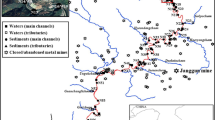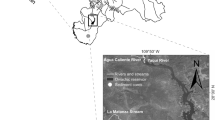Abstract
Urbanization and agriculture increase the risk of water contamination in watersheds. A special concern arises when this water is used for public supply. Conventional hydrochemical methods have been applied to identify contaminants in bulk water; however, there is lack of investigation of their origins. Environmental isotopes can be used to address such knowledge gap by tracking the harmful substance back to its origins. This study evaluates the interference of urbanization as well as inorganic fertilizers in the suspended sediments of the tributaries of two impoundments, whose water supplies 72% of the municipality of Caxias do Sul, Southern Brazil. To achieve this goal, the isotopic ratios 87Sr/86Sr, 208Pb/204Pb, 206Pb/204Pb, 207Pb/204Pb, 208Pb/206Pb and 207Pb/206Pb were selected as geochemical tracers, showing promising results to evaluate sources of contamination in source water. The results of strontium isotopes showed two distinct groups, one marked by the geogenic origin of the sediment and the other by inorganic fertilizers. Lead isotopes indicated that suspended sediments have signatures compatible with the rocks that occur in the region and are in a range of isotopic ratios different from fertilizers or copper sulfate.





Similar content being viewed by others
Data availability
All data generated or analysed during this study are included in this published article.
References
Åberg G, Löfvendahl R, Stijfhoorn D, Råheim A (1995) Provenance and weathering depth of carbonaceous gotland sandstone by use of carbon and oxygen isotopes. Atmos Environ 29:781–789. https://doi.org/10.1016/1352-2310(94)00324-E
Belladona R, De Vargas T (2017) Space-time precipitation distribution and the relevance of the orography of Caxias do Sul. Brazil Rev Bras Cartogr 69(3):607–620
Bellieni G, Comin-Chiaramonti P, Marques L et al (1984) High- and low-Ti flood basalts from the Paraná plateau (Brazil): petrology and geochemical aspects bearing on their mantle origin. N J Miner 150:273–306
Bellieni G, Comin-Chiaramonti P, Marques LS et al (1986) Petrogenetic aspects of acid and basaltic lavas from the Paraná Plateau (Brazil): geological, mineralogical and petrochemical relationship. J Pet 27(4):915–944
Bird G, Brewer PA, Macklin MG et al (2010) Quantifying sediment-associated metal dispersal using Pb isotopes: Application of binary and multivariate mixing models at the catchment-scale. Environ Pollut 158:2158–2169. https://doi.org/10.1016/j.envpol.2010.02.020
Böhlke JK, Horan M (2000) Strontium isotope geochemistry of groundwaters and streams affected by agriculture, Locust Grove, MD. Appl Geochem 15:599–609
Box MR, Krom MD, Cliff RA et al (2011) Response of the Nile and its catchment to millennial-scale climatic change since the LGM from Sr isotopes and major elements of East Mediterranean sediments. Q Sci Rev 30:431–442. https://doi.org/10.1016/j.quascirev.2010.12.005
Brasil (2005) Decreto nº 5.334. Diário Oficial da União, Presidência da República. In: https://www.planalto.gov.br/ccivil_03/_ato2004-2006/2005/decreto/d5334.htm. Accessed 05 Dec 2022
Buffon P, De Araújo B (2021) Utilização do Índice de Conformidade ao Enquadramento para Analisar a Qualidade da Água de duas Represas de Captação de Caxias do Sul (RS), Brasil. In: VIII Simpósio de ecologia de reservatórios. Minas Gerais, Brazil, p 163
Bullen TD, Kendall C (1998) Tracing of weathering reactions and water flowpaths: a multi-isotope approach. Isotope tracers in catchment hydrology. Elsevier Science B.V, Amsterdam, pp 611–646
Capo RC, Stewart BW, Chadwick OA (1998) Strontium isotopes as tracers of ecosystem processes: theory and methods. Geoderma 82:197–225. https://doi.org/10.1016/S0016-7061(97)00102-X
Caxias do Sul (City Hall) (2018) GeoEye satellite imagery. In: GeoCaxias Digit. Map. https://geopublico.caxias.rs.gov.br/geocaxias/map?config=src/webgis/config/map/config-all.xml. Accessed 18 Jan 2021
Charalampides G, Manoliadis O (2002) Sr and Pb isotopes as environmental indicators in environmental studies. Environ Int 28:147–151. https://doi.org/10.1016/S0160-4120(02)00020-X
Clark ID, Fritz P (1999) Water-rock interaction. Environmental isotopes in hydrogeology. CRC Press, Boca Raton, pp 217–217
Conama (National Environment Council) (2009) Resolution CONAMA 420/2009. Ministry of the Environment, Brazil
Cordani U, Civetta L, Mantovani M et al (1988) Isotope geochemistry of flood volcanism from the Paraná Basin (Brazil). The Mesozoic flood volcanism of the Paraná basin: petrogenetic and geophysical aspects. IAG-USP Press, São Paulo, pp 157–178
de Lima EF, Philipp RP, Rizzon GC et al (2012) Sucessões vulcânicas, modelo de alimentação e geração de domos de lava ácidos da Formação Serra Geral na região de São Marcos-Antônio Prado (RS). Geol USP Ser Cient 12:49–64. https://doi.org/10.5327/Z1519-874X2012000200004
de Lima EF, Waichel BL, Rossetti LDMM et al (2018) Feeder systems of acidic lava flows from the Paraná-Etendeka Igneous Province in southern Brazil and their implications for eruption style. J South Am Earth Sci 81:1–9. https://doi.org/10.1016/j.jsames.2017.11.004
de Vargas T, Roisenberg A, Pulgati FH (2018) Contamination of botton sediments in the watersheds of public supply in Caxias do Sul, RS. Geociencias 37:331–346. https://doi.org/10.5016/geociencias.v37i2.12019
De Vargas T, Belladona R, Dal Bosco V et al (2021) Análise de homogeneidade da geoquímica de sedimentos das bacias de captação Faxinal e Maestra: a hipótese é nula (Ho)? In: Schneider VE, Bortolin TA, Carra SHZ (eds) Gestão e tecnologias para o meio ambiente: visões e ações interdisciplinares. Educs, Caxias do Sul, pp 109–117
Erel Y (1998) Mechanisms and velocities of anthropogenic Pb migration in Mediterranean soils. Environ Res 78:112–117. https://doi.org/10.1006/enrs.1997.3811
Geraldes MC, Paula AH, Godoy JM, Valeriano CM (2006) Pb isotope signatures of sediments from Guanabara Bay, SE Brazil: evidence for multiple anthropogenic sources. J Geochem Explor 88:384–388. https://doi.org/10.1016/j.gexplo.2005.08.081
Grezzi G, Ayuso RA, De Vivo B et al (2011) Lead isotopes in soils and groundwaters as tracers of the impact of human activities on the surface environment: the Domizio-Flegreo Littoral (Italy) case study. J Geochemical Explor 109:51–58. https://doi.org/10.1016/j.gexplo.2010.09.012
Hansmann W, Köppel V (2000) Lead-isotopes as tracers of pollutants in soils. Chem Geol 171:123–144
Hawkesworth C, Gallagher K, Kelley S et al (1992) Paraná magmatism and opening of the South Atlantic. Geol Soc London 68:221–240
Hosono T, Nakano T, Igeta A et al (2007) Impact of fertilizer on a small watershed of Lake Biwa: use of sulfur and strontium isotopes in environmental diagnosis. Sci Total Environ 384:342–354. https://doi.org/10.1016/j.scitotenv.2007.05.033
IBGE (Instituto Brasileiro de Geografia e Estatística) (2021) Cidades e Estados: população estimada. https://www.ibge.gov.br/cidades-e-estados/rs/caxias-do-sul.html. Accessed 7 Oct 2021
Komárek M, Ettler V, Chrastný V, Mihaljevič M (2008) Lead isotopes in environmental sciences: a review. Environ Int 34:562–577. https://doi.org/10.1016/j.envint.2007.10.005
Köppen W, Geiger R (1928) Klimate der Erde. Gebrüder Borntraeger, Berlin
Kuhn IA (2011) Análise multi-elementar e transferência de metais e isótopos de chumbo no sistema planta-solo-água subterrânea em área contaminada por calda bordalesa na região vinífera. Federal University of Rio Grande do Sul, Porto Alegre
Li X, Shen Z, Wai WH, Li Y-S (2001) Chemical forms of Pb, Zn and Cu in the sediment Pro®les of the Pearl River Estuary. Mar Pollut Bull 42:215–223
Lisboa NA, Remus MVD, Dani N (2003) Estudo geológico e hidrogeológico regional para o aproveitamento de água do aqüífero Guarani no município de Caxias do Sul. UFRGS, Porto Alegre, Brazil
Martin CE, McCulloch MT (1999) Nd-Sr isotopic and trace element geochemistry of river sediments and soils in a fertilized catchment. Elsevier, New South Wales
Mirlean N, Robinson D, Kawashita K et al (2005) Identification of local sources of lead in atmospheric deposits in an urban area in Southern Brazil using stable lead isotope ratios. Atmos Environ 39:6204–6212. https://doi.org/10.1016/j.atmosenv.2005.07.002
Oliveira DC, Lafon JM, de Oliveira LM (2016) Distribution of trace metals and Pb isotopes in bottom sediments of the Murucupi River, North Brazil. Int J Sediment Res 31:226–236. https://doi.org/10.1016/j.ijsrc.2016.05.001
Peate DW (1989) Stratigraphy and petrogenesis of Paraná Continental Flood Basalts. The Open University, Southern Brazil
Pierson-Wickmann AC, Aquilina L, Weyer C et al (2009) Acidification processes and soil leaching influenced by agricultural practices revealed by strontium isotopic ratios. Geochim Cosmochim Acta 73:4688–4704. https://doi.org/10.1016/j.gca.2009.05.051
Pinto VM, Hartmann LA, Santos JOS et al (2011) Zircon U–Pb geochronology from the Paraná bimodal volcanic province support a brief eruptive cycle at ~ 135 Ma. Chem Geol 281:93–102. https://doi.org/10.1016/j.chemgeo.2010.11.031
Riou C (1995) Sources Des Excès de Phophore Dans Les Eaux Superfìcilles de Bretagne. Université de Rennes 1, Rennes
Roisenberg A, Viero APO (2000) Vulcanismo Mesozóico da Bacia do Paraná no Rio Grande do Sul. In: Holz M, De Ros F (eds) Geologia do Rio Grande do Sul. CIGO/UFRGS, Porto Alegre, pp 355–374
Santos SN, Lafon JM, Corrêa JAM et al (2012) Distribuição e assinatura isotópica de Pb em sedimentos de fundo da foz do Rio Guamá e da Baía do guajará (Belém - Pará). Quim Nova 35:249–256. https://doi.org/10.1590/S0100-40422012000200004
Shepherd TJ, Chenery SRN, Pashley V et al (2009) Regional lead isotope study of a polluted river catchment: River Wear, Northern England, UK. Sci Total Environ 407:4882–4893. https://doi.org/10.1016/j.scitotenv.2009.05.041
Streck EV, Kämpf N, Dalmolin RSD et al (2008) Solos do Rio Grande do Sul, 2nd edn. EMATER/RS-ASCAR, Porto Alegre
Tarzia M, De Vivo B, Somma R et al (2002) Anthropogenic vs. natural pollution: an environmental study of an industrial site under remediation (Naples, Italy). Geochem Explor Environ Anal 2:45–56. https://doi.org/10.1144/1467-787302-006
Techer I, Lancelot J, Descroix F, Guyot B (2011) About Sr isotopes in coffee “Bourbon Pointu” of the Réunion Island. Food Chem 126:718–724. https://doi.org/10.1016/j.foodchem.2010.11.035
Theuring P, Rode M, Behrens S et al (2013) Identification of fluvial sediment sources in the Kharaa River catchment, Northern Mongolia. Hydrol Process 27:845–856. https://doi.org/10.1002/hyp.9684
Townsend AT, Seen AJ (2012) Historical lead isotope record of a sediment core from the Derwent River (Tasmania, Australia): a multiple source environment. Sci Total Environ 424:153–161. https://doi.org/10.1016/j.scitotenv.2012.02.011
Umann LV, De lima EF, Sommer CA, De Liz DJ (2001) Vulcanismo ácido da região de cambará do sul; rs: litoquímica e discussão sobre a origem dos depósitos. Rev Bras Geociências 31:357–364
De Vargas T, Adami MVD, Aver E de AS, et al (2013) Monitoramento hidroquímico dos córregos afluentes da represa Faxinal, Caxias do Sul-RS. In: XX Brazilian Symposium on Water Resources, Bento Gonçalves, Brazil
Wayne UA, Ronald GS, Woodland EE (1970) Isotopic composition as a natural tracer of lead in the environment. Environ Sci Technol 4:305–313
Widory D, Kloppmann W, Chery L et al (2004) Nitrate in groundwater: an isotopic multi-tracer approach. J Contam Hydrol 72:165–188. https://doi.org/10.1016/j.jconhyd.2003.10.010
Zhang W, Feng H, Chang J et al (2008) Lead (Pb) isotopes as a tracer of Pb origin in Yangtze River intertidal zone. Chem Geol 257:257–263. https://doi.org/10.1016/j.chemgeo.2008.10.012
Zhang F, Jin Z, Li F et al (2013) The dominance of loess weathering on water and sediment chemistry within the Daihai Lake catchment, northeastern Chinese Loess Plateau. Appl Geochem 35:51–63. https://doi.org/10.1016/j.apgeochem.2013.05.013
Acknowledgements
The authors thank the Public Water and Wastewater Service of the city of Caxias do Sul for the great logistic support to this research.
Funding
The authors declare that no funds, grants or other support was received during the preparation of this manuscript.
Author information
Authors and Affiliations
Contributions
All authors contributed to the study conception and design. Material preparation, data collection and analysis were performed by TDV, AR and RB. The first draft of the manuscript was written by TDV and all authors commented on previous versions of the manuscript. All authors read and approved the final manuscript.
Corresponding author
Ethics declarations
Conflict of interest
The authors have no relevant financial or non-financial interests to disclose.
Additional information
Publisher's Note
Springer Nature remains neutral with regard to jurisdictional claims in published maps and institutional affiliations.
Rights and permissions
Springer Nature or its licensor (e.g. a society or other partner) holds exclusive rights to this article under a publishing agreement with the author(s) or other rightsholder(s); author self-archiving of the accepted manuscript version of this article is solely governed by the terms of such publishing agreement and applicable law.
About this article
Cite this article
De Vargas, T., Roisenberg, A. & Belladona, R. Strontium and lead isotopes as environmental tracers in a water supply watershed in Southern Brazil. Environ Earth Sci 81, 544 (2022). https://doi.org/10.1007/s12665-022-10671-8
Received:
Accepted:
Published:
DOI: https://doi.org/10.1007/s12665-022-10671-8




